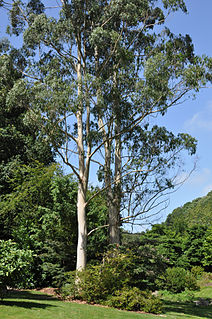
Eucalyptus dalrympleana, commonly known as mountain gum, mountain white gum, white gum and broad-leaved ribbon gum, is a species of tree that is endemic to southeastern Australia. It has smooth bark, lance-shaped adult leaves, flower buds in groups of three or seven, white flowers and cup-shaped, bell-shaped or hemispherical fruit.

Eucalyptus scoparia, commonly known as the Wallangarra white gum or willow gum, is a small to medium-sized tree that is endemic to a small area of eastern Australia. It has smooth bark, linear to lance-shaped or curved adult leaves, flower buds in groups of seven, white flowers and cup-shaped, hemispherical or bell-shaped fruit. It is restricted to a few rocky mountains near the border between New South Wales and Queensland but is widely cultivated.

Eucalyptus propinqua, commonly known as the grey gum or small-fruited grey gum, is a species of medium-sized to tall tree that is endemic to eastern Australia. It has smooth, mottled bark, lance-shaped to curved adult leaves that are paler on the lower surface, flower buds in groups of between seven and fifteen, white flowers and conical or hemispherical fruit.

Eucalyptus albens, known as the white box, is a common tree of the western slopes and plains of New South Wales and adjacent areas in Queensland and Victoria. It has rough, fibrous bark on the base of its trunk and smooth, white bark above. The leaves are lance-shaped and groups of seven spindle-shaped flower buds are arranged in leaf axils or on the ends of the branches. White flowers are mostly present between August and February and the fruit are barrel-shaped to urn-shaped.
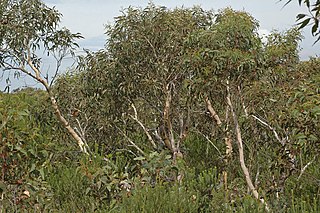
Eucalyptus racemosa, commonly known as snappy gum or narrow-leaved scribbly gum, is a species of small to medium-sized tree that is endemic to eastern Australia. It has smooth, mottled bark, lance-shaped to curved or egg-shaped adult leaves, flower buds in groups of between seven and fifteen, white flowers and cup-shaped, conical or hemispherical fruit.

Eucalyptus pellita, commonly known as the large-fruited red mahogany, is a species of medium to tall tree that is endemic to north-eastern Queensland. It has rough, fibrous or flaky bark on the trunk and branches, lance-shaped to egg-shaped adult leaves, flower buds in groups of seven, white flowers and cup-shaped to conical fruit.

Eucalyptus kartzoffiana, commonly known as the Araluen gum, is a species of medium-sized tree that is endemic to a small area of southeastern New South Wales. It has rough, fibrous or flaky bark on part or most of its trunk, lance-shaped or curved adult leaves, flower buds in groups of three, white flowers and sessile, bell-shaped fruit.

Eucalyptus benthamii, commonly known as Camden white gum, Bentham's gum, Nepean River gum, kayer-ro or durrum-by-ang, is a species of tree that is endemic to New South Wales. It has mostly smooth bluish grey or white bark, lance-shaped to curved adult leaves, flower buds arranged in groups of seven, white flowers and cup-shaped, bell-shaped or conical fruit.

Eucalyptus cambageana, commonly known as the Dawson River blackbutt, Dawson gum or Coowarra box, is a species of tree that is endemic to Queensland, Australia. It is a medium-sized tree with hard, rough bark on the lower trunk, smooth white to cream-coloured bark above, lance-shaped or curved adult leaves, flower buds in groups of seven, white flowers and cup-shaped to funnel-shaped fruit.
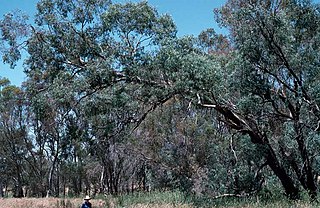
Eucalyptus cadens, commonly known as the tumble-down swamp gum or Warby Range swamp-gum is a small to medium-sized tree that is endemic to a small area in north-eastern Victoria, Australia. It has rough, compacted bark on the trunk and larger branches, smooth bark above, narrow elliptic to lance-shaped adult leaves, flower buds in groups of seven, white flowers and conical fruit.
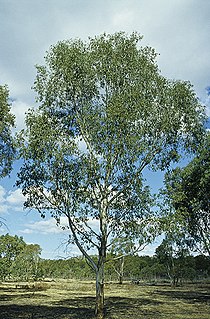
Eucalyptus chloroclada, commonly known as Baradine gum, red gum or dirty gum, is a species of small to medium-sized tree that is endemic to eastern Australia. It usually has fibrous to flaky bark on the trunk and smooth bark above, lance-shaped adult leaves, flower buds in groups of seven, white flowers and hemispherical fruit.
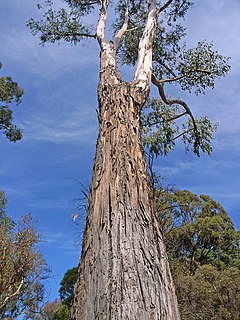
Eucalyptus dunnii, commonly known as Dunn's white gum or simply white gum, is a species of medium-sized to tall tree that is endemic to eastern Australia. It has rough bark near the base, smooth white to cream-coloured bark above, lance-shaped to curved adult leaves, flower buds in groups of seven, white flowers and cup-shaped, conical or hemispherical fruit.
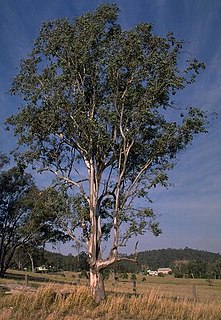
Eucalyptus glaucina, commonly known as the slaty red gum, is a species of small to medium-sized tree endemic to New South Wales. It has smooth, white and grey bark, lance-shaped adult leaves, flower buds in groups of seven, white flowers and hemispherical fruit with the valves protruding well above the level of the rim.
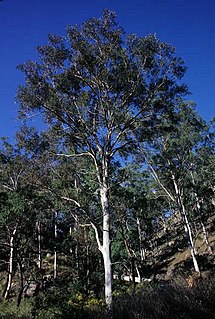
Eucalyptus major, commonly known as grey gum, is a species of tree that is endemic to a small area near the New South Wales - Queensland border. It has smooth greyish bark, lance-shaped adult leaves, flower buds in groups of seven and conical to cup-shaped fruit.
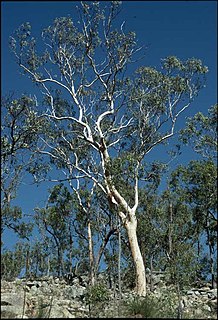
Eucalyptus pachycalyx, commonly known as the shiny-barked gum, is a species of tree that is endemic to north-eastern Australia. It has smooth, pale grey, mottled bark, lance-shaped or curved adult leaves, white flowers and cup-shaped or hemispherical fruit.

Eucalyptus herbertiana, commonly known as Kalumburu gum or yellow-barked mallee, is a species of small tree or mallee that is endemic to northern Australia. It has smooth bark, lance-shaped or curved adult leaves, flower buds in groups of seven, white flowers and cup-shaped, hemispherical or conical fruit.
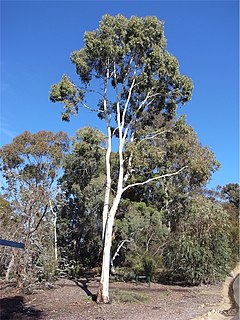
Eucalyptus argophloia, commonly known as Queensland western white gum, Queensland white gum, scrub gum, lapunyah, Burncluith gum or Chinchilla white gum is a tree that is endemic to a small area of Queensland. It has smooth white bark ageing to other colours, narrow lance-shaped adult leaves, more or less spherical flower buds in groups of seven, white flowers and small, hemispherical to cup-shaped fruit.

Eucalyptus decorticans, commonly known as the gum-top ironbark, is a species of tree that is endemic to Queensland. It has rough, dark grey or black "ironbark" on the trunk and larger branches, smooth white bark on the thinner branches, lance-shaped to curved adult leaves, flower buds in groups of seven, white flowers and conical, cup-shaped or barrel-shaped fruit.
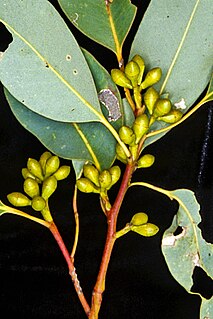
Eucalyptus grisea, commonly known as grey gum, is a species of tree that is endemic to central Queensland. It has smooth greyish bark, lance-shaped to egg-shaped adult leaves, flower buds in groups of seven, white flower and usually cup-shaped fruit.
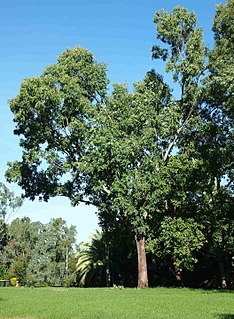
Eucalyptus raveretiana, commonly known as the black ironbox, is a species of small to medium-sized tree that is endemic to Queensland. It has rough, fibrous or flaky bark on the trunk and larger branches, smooth pale grey bark above, lance-shaped leaves, flower buds in groups of seven on a branched peduncle, white flowers and small, hemispherical fruit.





















